Planting rhizome (bearded and beardless) irises in spring and autumn: rules of care and cultivation
In its own way, rhizome irises look tempting and attractive (they are also sometimes called cockerels and irises because of the shape of the flowers) in a country flower bed. Such an eye-pleasing floral effect, as well as a wonderful aroma, are achieved thanks to proper agricultural technology. How to correctly plant bearded and beardless irises in autumn and spring, about the intricacies of care and cultivation, about dividing and transplanting to a new place, is discussed in our article.
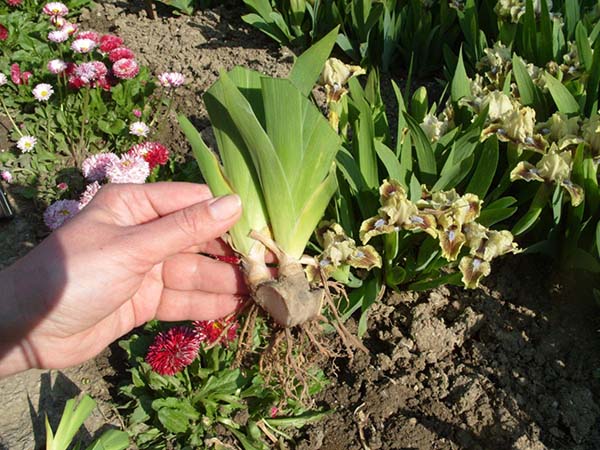
Content
- 1 Rhizome and bulbous irises
- 2 Types and varieties of rhizome irises
- 3 When to plant and replant irises: in spring, summer or autumn
- 4 How to choose iris seedlings
- 5 Division and transplant of irises to a new place
- 6 How to plant irises in the country
- 7 Outdoor iris care
- 8 Why irises don't bloom: reasons and what to do
Rhizome and bulbous irises
Actually, irises are a genus of perennial rhizomatous plants that belongs to the Iris or Iris family.It is about them that will be discussed in this article. But there are also bulbous irises belonging to another genus (more precisely, to three separate genera).
Note! About planting, growing and care for bulbous irises (xyphium, iridodictium and juno) you can read in this article.
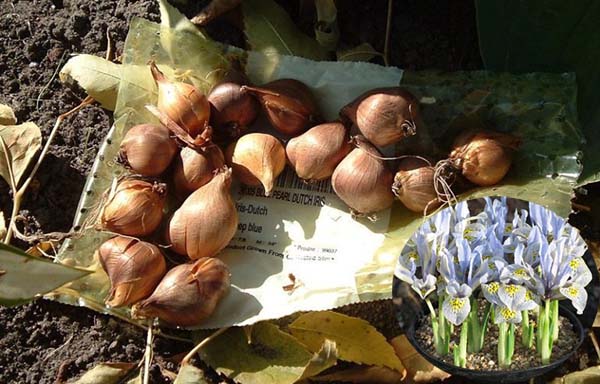
Types and varieties of rhizome irises
There are several classifications of irises according to their species, as well as varieties (American and Russian societies of iris growers).
Typically, irises are divided into bearded (tall, standard, dwarf) and beardless (for example, Siberian, Japanese, Louisiana, Californian).
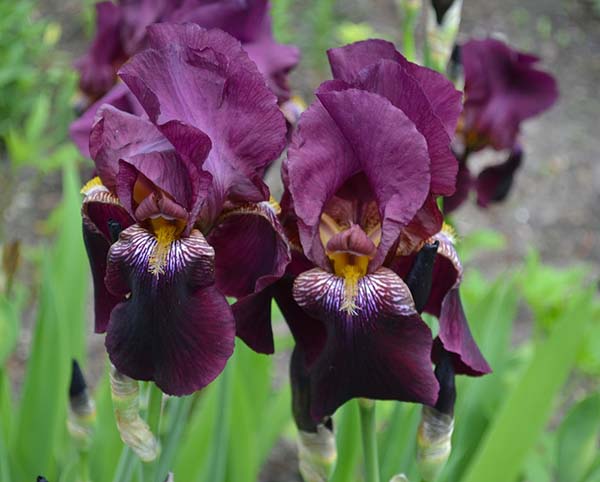
The flowers themselves, depending on the varieties, have a wide variety of colors - from light colors (white, blue) to very dark (dark blue).
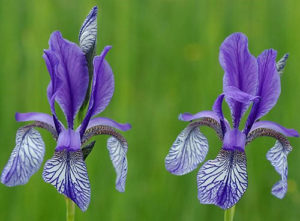
When to plant and replant irises: in spring, summer or autumn
In principle, irises can be planted throughout the growing season, that is, from early spring to autumn. In most cases, this is done before flowering (early spring) and after (summer), as well as in August-early September (autumn), when the flower wakes up again after summer hibernation.
Most often, irises are transplanted after flowering, when the peduncles are cut. Therefore, with regard to the approximate timing, it is best to transplant (divide, propagate) irises to a new place in June-early July, 2-3 weeks after their flowering.
How to choose iris seedlings
When buying an iris seedling on the market, it is convenient to choose exactly the flowering specimens in order to be completely sure which variety you are purchasing.
Important! It is worth remembering that a flowering plant is less well accepted and takes a long time to get away from such (transplanting to a new place in open ground) shock.
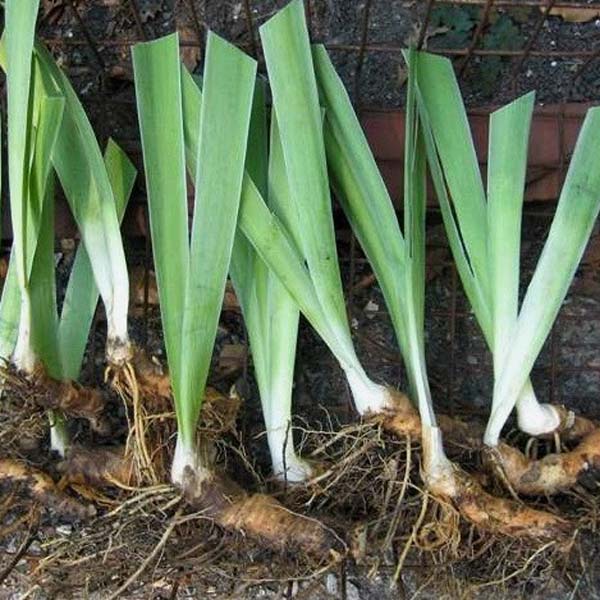
Also, when choosing a seedling, it is best to stop at such a plant, which, next to the main stem (with a peduncle), still has 2 sprouts (children). When such an iris is planted, it will bloom next year. If a seedling has only 1 sprout, then flowering will have to wait 2 years, since the next year the plant will develop and give a new growth.
Division and transplant of irises to a new place
The need for periodic transplantation (dividing the bushes) of irises is due to the fact that over time the plant grows to the sides, which makes the middle of the bush bare, and the flowers and shoots begin to shrink.
Note! Thus, in one place, iris bushes can grow up to 3-5 years.
Video: when and how to divide (propagate) irises
Step-by-step guide to transplanting (dividing) irises:
- Dig up the bush with a garden fork or shovel.
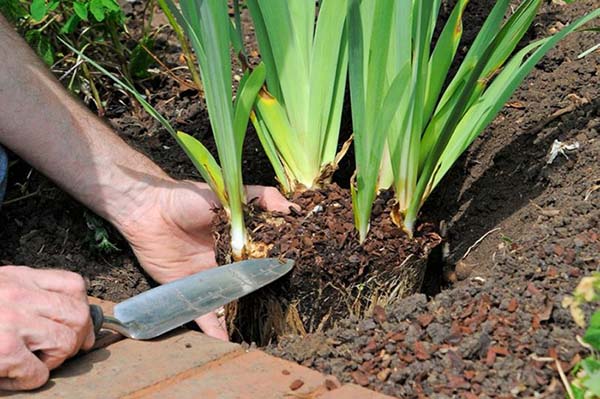
- Divide with your hands into separate divisions.
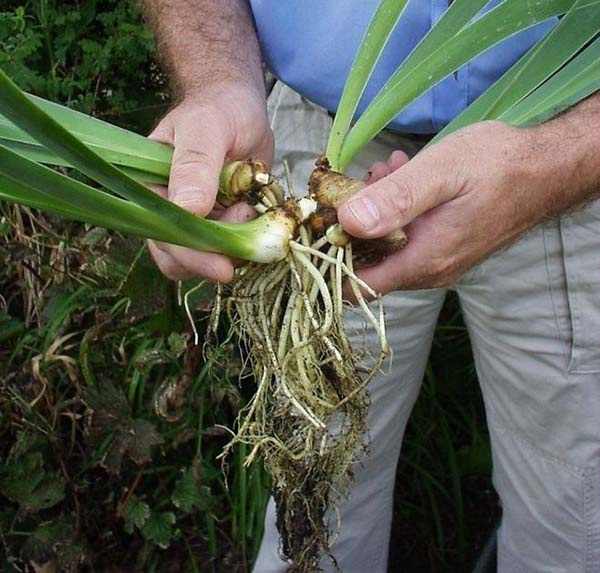
- Use a knife if necessary.
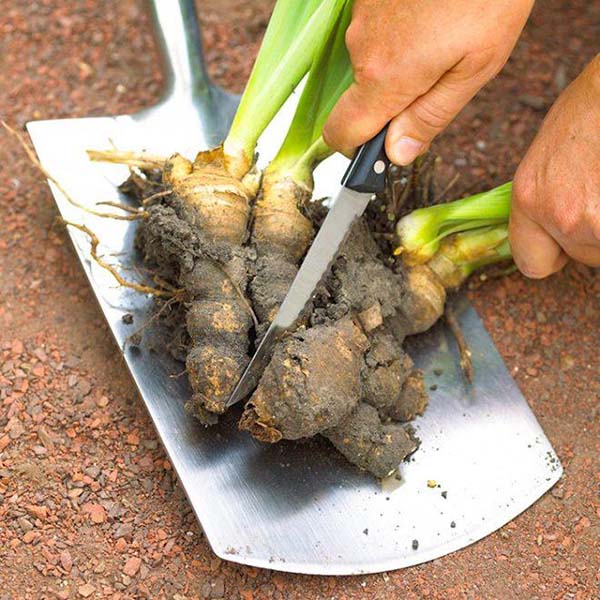
- Examine the roots and remove all dry and rotten ones, and healthy ones - root up to 5-8 cm.
- Cut off the foliage fan at least by half, or better by 1/3, that is, leaving somewhere 10-15 centimeters (it is most convenient to do this "house"). Why a house or a fan? So less moisture will get into the bush. If you have not previously removed, then it's time to cut off the peduncle.
- Experienced flower growers recommend not planting the cuttings right away, but thoroughly drying them in the sun for a day, so that a cork layer forms on the cuts (not leaves, but on the cuttings), so to speak, the wounds are closed (the plant has withered). Or you can process the cut with crushed coal or brilliant green and plant it right away. If this is not done, then the plant will fall ill with such a dangerous fungal disease as root rot.
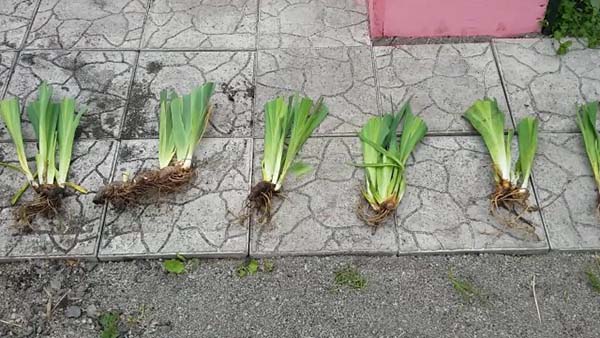
- You will find further landing steps in the next paragraph.
By the way! Many gardeners transplant and plant irises without any pruning and they are well received. But, by pruning, you significantly increase the likelihood of plant survival in a new place (roots = green mass), so the choice is yours.
How to plant irises in the country
In order for irises in the country to feel comfortable, grow and develop normally, they need to choose a suitable place and soil when planting.
The choice of location and soil
Irises are very fond of the sun, so they need to find an appropriate "warm" place in the garden. If the plants do not warm up well in the sun, then there can be no talk of any flowering. Therefore, it is strictly forbidden to plant them in the shade.
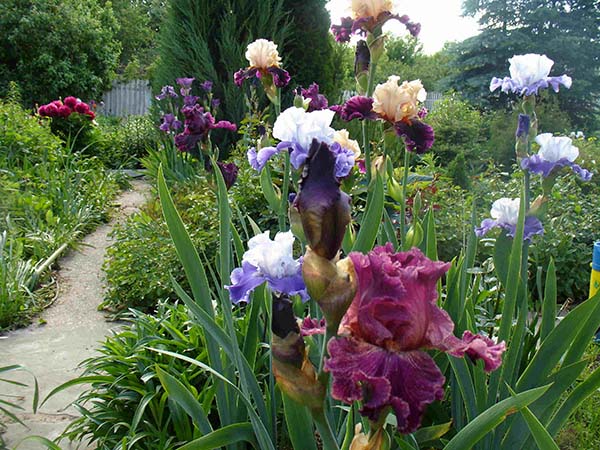
For successful cultivation, irises should be planted in light and nutritious soil, which is characterized by good air and moisture permeability. If your soil is heavy, the nutrient mixture for filling the hole should be prepared from sand and peat. And Irins do not tolerate acidic soils (you can deoxidize with the help dolomite flour, lime, wood ash).
Direct landing
Step-by-step instructions for planting irises in open ground:
- Decide on a place to grow.
- Make landing holes.
- Cut the foliage by 1/3 with a house (this was described in the previous paragraph about transplantation and division).And also get rid of the peduncle (if any).
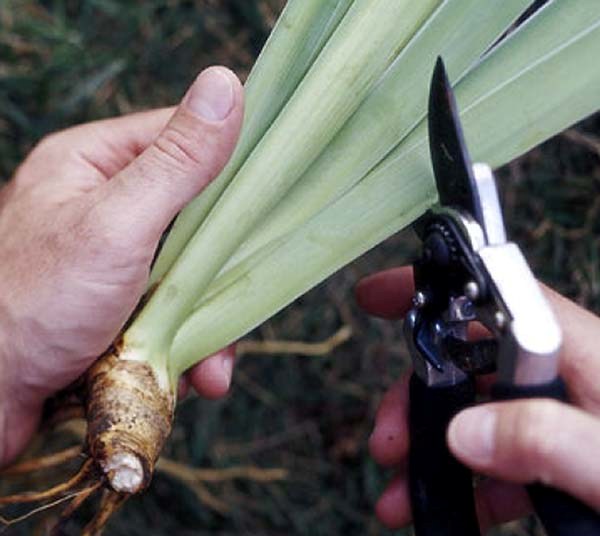
- The most important thing when planting is that in no case should the root system of the plant be buried, since it is located almost on the soil surface. Therefore, it is necessary to plant rhizomes as close to the surface as possible so that they, so to speak, shine through. It is best to put a small mound (a mixture of loose soil with sand), on which you put the rhizomes and spread the roots.
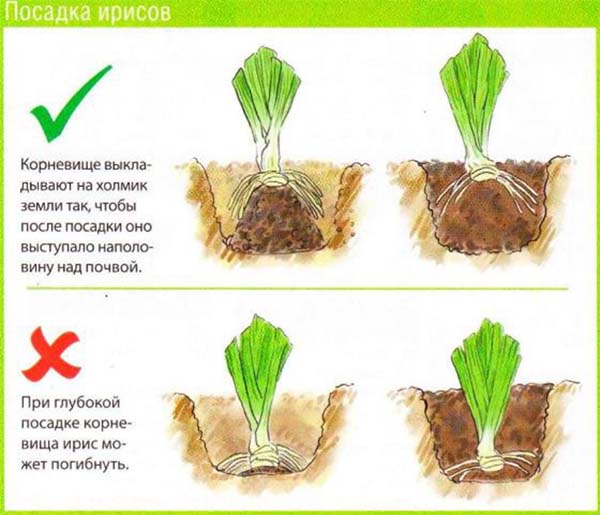
- The optimal distance between plants is 20-40 cm. It will be nice to arrange the irises in the shape of a triangle.
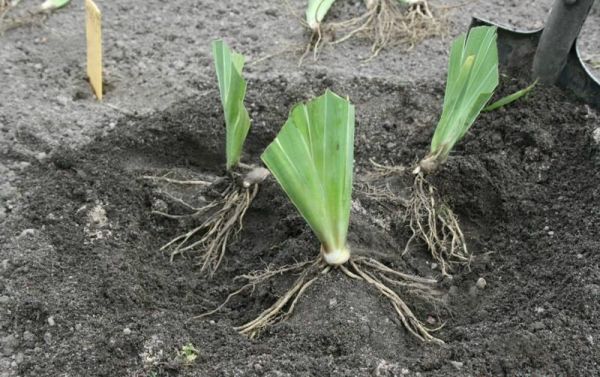
- Next, you need to carefully cover it with nutritious soil.
- Water abundantly.
- Mulch (optional).
Video: how to plant irises
Video: how to plant iris in open ground from a pot
Outdoor iris care
It is quite simple to care for irises. You just need to know the basic rules for growing them in the open field. As a rule, care comes down to timely watering, fertilizing, protection and pest control, summer pruning (optional) and preparation for winter (shelter), as well as dividing (reproducing) a growing bush and replanting it to a new place.
Advice! If you have planted the tallest irises in a place unprotected from strong drafts, or it is generally typical for your area, then it's better to tie them to the supportsso that the peduncles do not break off during the wind.
Watering
Most often, watering irises is remembered only closer to the beginning of their flowering (during the budding period), since in early spring the plants usually have enough natural moisture. In summer, when the weather is dry and hot, watering, of course, needs to be carried out periodically (about 2 times a week). Naturally, after each watering, it is advisable to carefully loosen the soil (remember, the root system is rather superficial), or you can mulch the soil once so that the moisture is better retained and does not evaporate for a long time.
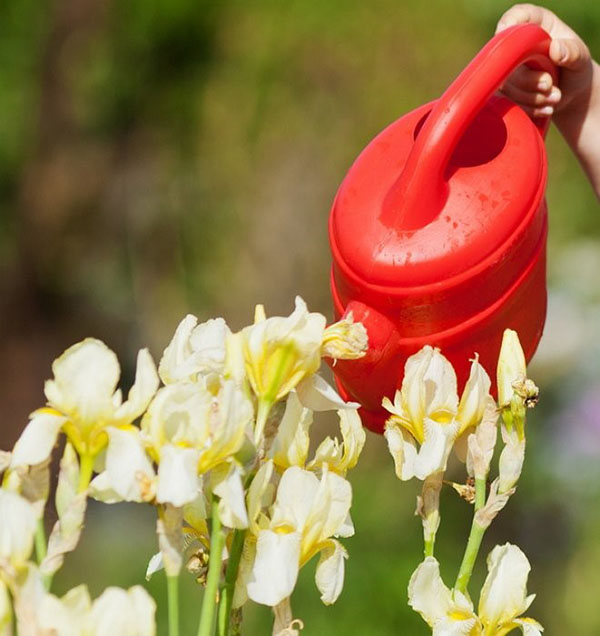
Advice! Watering is best done in the late evening, after sunset. In this case, it is very advisable not to fall on the flowers, unless, of course, you want to spoil them.
With the onset of autumn (a gradual decrease in temperature and an increase in the amount of rain), watering is reduced, since the plant can rot due to excessive moisture.
Top dressing
Irises, as a rule, are fed according to the standard scheme:
- in early spring after the snow melts, when the first leaves appear (to build up green mass) - nitrogen fertilizer (urea or ammonium nitrate);
- in the spring during the budding period (for better flowering) - complex fertilizer with nitrogen, potassium and phosphorus (ammophoska);
- in summer after flowering, after about 2-3 weeks (for planting better quality flower buds) - phosphorus-potassium fertilizer (for example, diammophos or monophosphate).
Important! All top dressing is carried out on wet ground and only in the form of irrigation solutions, since dry fertilizers will necessarily burn the roots that are very close to the surface.
Pruning after flowering and ospring preparation for winter
Note! About, how to care for irises after flowering, as well as in autumn during their preparation for winter, disassembled in detail here.
Why irises don't bloom: reasons and what to do
There are a number of reasons for the lack of flowering in a beautiful perennial. Below are some suggestions for solving this rather unpleasant problem.
Too young seedling
One of the reasons why a planted iris may not bloom for a long time is the small size of the division. Delenka should have a fairly large root, on which 3 points of growth are desirable.
Excessive deepening
As a rule, the absence or weak flowering of irises is explained by the fact that you deepened the rhizomes too much when planting or transplanting a plant, therefore the "back" (the upper part of the rhizome) of the flower does not warm up enough, and this is a prerequisite for the successful cultivation of these flowers. The flower needs to be transplanted, and now do it right.

Do not forgetthat for flowering irises need a lot of light, which means the place for their planting should be sunny.
Iris fly and its larvae


If the irises do not bloom, and some sticky rot has formed in the place where the flower should be, then it is actually the larvae of the iris fly who tried.
How did this happen?
Flies lay eggs in buds, their white translucent larvae eat the buds from the inside, leaving their excrement in them, which causes decay. As a result, the buds do not turn into flowers.
How to get rid of the iris fly?
It is necessary to spray the plants before flowering (when the buds have just started to come out) with one of the systemic insecticides, for example, "Aktellikom". Or you can water the flowers under the root with Aktara solution. Thus, the fly, which is still in the ground, will die, and if it does not die and nevertheless lays eggs in the buds, then its larvae will feed on the already poisoned juice from the plant and subsequently also die.
The rhizomatous iris flower, while not being such a capricious plant, still has certain subtleties for planting in spring and autumn. Considering them, as well as the rules of care and cultivation, you can achieve active flowering of this magnificent perennial
Video: everything about planting irises